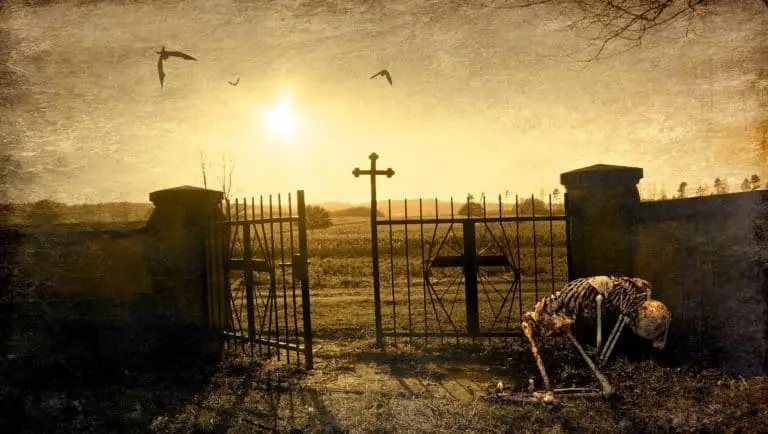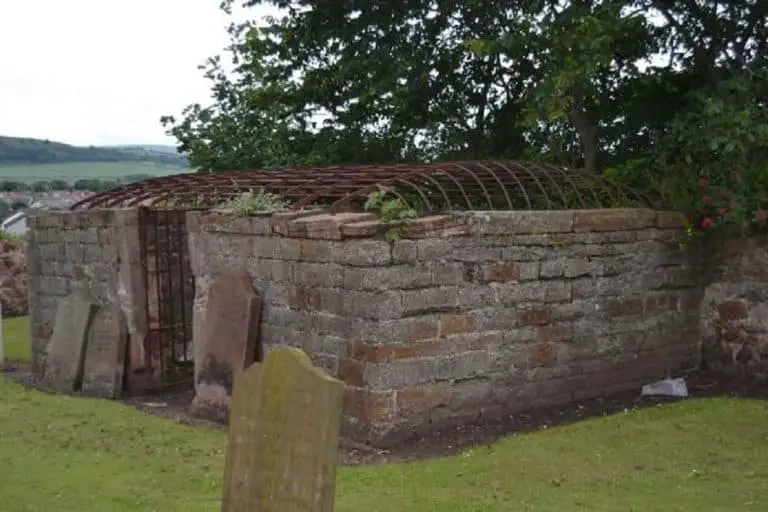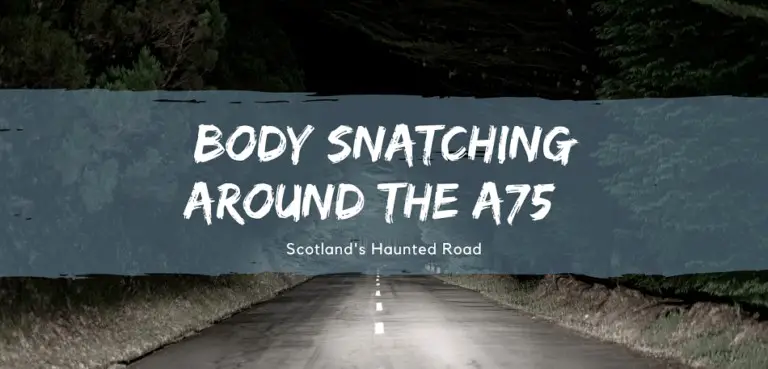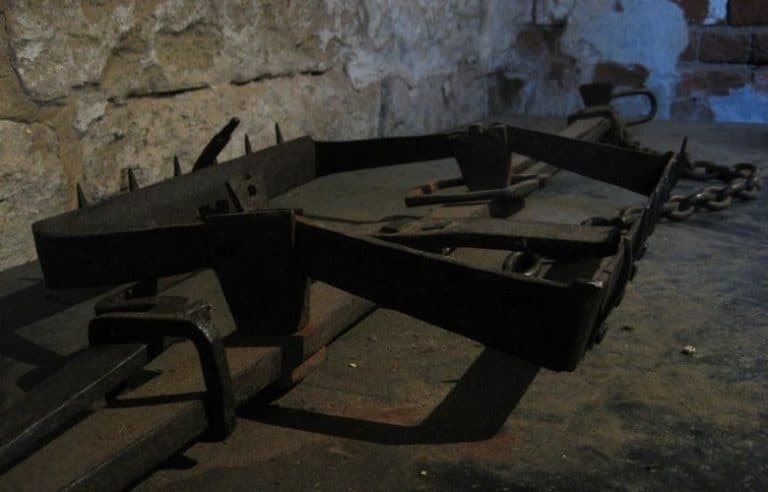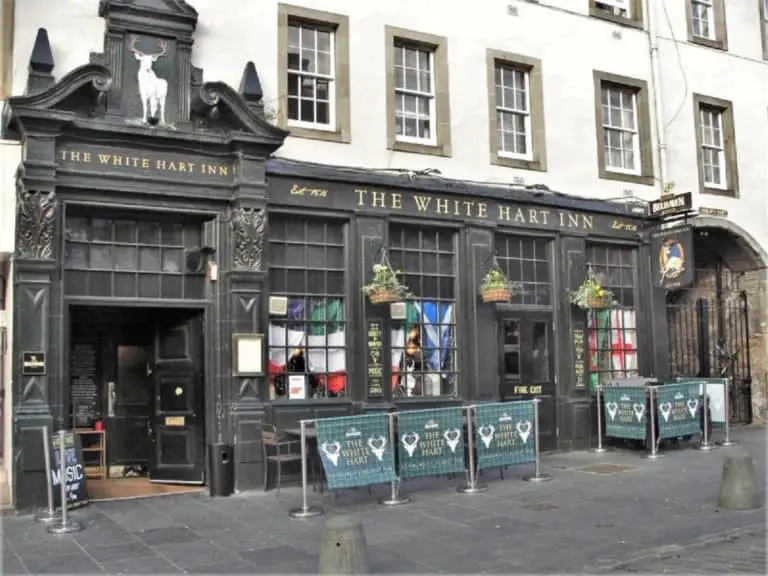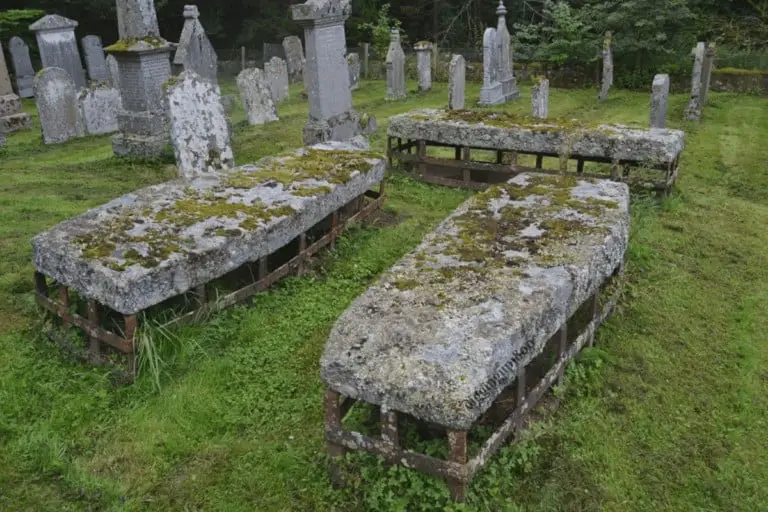Edinburgh’s First Body snatchers (Waldie & Torrence)
Long before Burke and Hare had perfected the subtle art of Burking, two women from Edinburgh were doing just that. Stifling a corpse and selling it to the anatomy students.
But who were Edinburgh’s first body snatchers?
Jean Waldie and Helen Torrence are often given this accolade after they murdered 9-year-old John Dallas, a sickly child who was supposedly not far from his death bed. They were sentenced to death by hanging on 18 March 1752 in Edinburgh’s Grassmarket. They are considered to be the first people executed for murdering victims for anatomical purposes.
But just who were these two women who have been given such a prestigious label when in effect, they were just like Burke and Hare, murderers killing for the dissecting table.
I decided to look into the story behind Jean Waldie and Helen Torrence and shed a little light on why they weren’t actually body snatchers at all.

Discovering Jean Waldie & Helen Torrence
She lived in her small tenement, not too far from St Giles Cathedral with her husband John Fair, a stabler’s servant.
Both women were fond of drink. Ale by the looks of things, rather than gin, and throughout their brief murderous episode, ale appears to have played a large part in their plan.
Due to Waldie’s role as a sick-nurse, she was perhaps well suited to supply the anatomy students and surgeon apprentices of Edinburgh with a steady supply of cadavers.
But it is not recorded if Waldie, or for that matter Torrence, regularly supplied the anatomy tables with the dead children of Edinburgh that died whilst in their care.
What we do know for a fact, however, is that on the night of November 30, 1751, Waldie had promised the body of a child that she was currently ‘sitting up with’ to a surgeon apprentice, confident that the child wouldn’t last for many more days.
Body For Sale
Her plan was simple. When the child died, instead of placing it in the coffin ready for burial as she should have, she would substitute the weight in the coffin for something else, most probably sand or stones, and secrete the corpse away to the apprentices.
But the mother of the child that had been promised got cold feet and pulled out of the bargain that she’s made with Waldie, leaving Waldie not only out of pocket but also unable to fulfil her half of the bargain with the apprentices.
The Plan
Perhaps feeling a little scorned, Jean Waldie now had to formulate a new plan in which to obtain a cadaver.
Having made her way downstairs to the tenement rooms of her neighbour Helen Torrence, both women were enjoying a pint of ale when Janet Johnson, having earlier dropped off some linen to Torrence to make some shirts, arrived to collect them.
The Victim
John Dallas Jnr was a sickly child. At only 9 years of age, he was already suffering from the loss of hearing and speech due to scrofula, something that perhaps the surgeons would have been interested in investing maybe.
He rarely, if ever let the house, and even on the day of his kidnapping, he was found leaning against the windowsill, gazing out of the window.
But that’s not to say that he never left the house. Unknown to Waldie, John Dallas Jnr was starting to recover and had made a few tentative trips to the tenements communal stairway using a form of sign language as means of communicating his needs.
His sudden disappearance then would have roused suspicion.
The Murder
Having already made her excuses to Helen and Janet, Waldie had left the two women drinking and removed herself to her rooms upstairs.
Signalling to Torrence that she wanted to speak to her in private through a series of taps on the floorboards, the two women decided that Torrence was to go Dallas’s home and report back to as to whether she thought the coast would be clear and that Waldie could take the boy without being seen.
John Dallas lived with his parent in what is now known as Stevenlaw’s Close but in the 1750’s went by the name of Stainielaw’s Close, not too far from Waldie’s doorstep. A short walk indeed in which to carry a child in one’s petticoats.
It didn’t take Waldie long to persuade John to leave the house with her, and after wrapping him in her petticoats, he was dead by the time he arrived at Fairlie’s Close.
Waldie then calmly put the limp body of John Dallas Jnr down onto a chest of drawers and slipped away to inform some apprentices with a Dr Russell that a cadaver was available for purchase.
The Exchange
Waldie called on medical student Andrew Anderson and fellow apprentices James Flint and James Arthur, all associated with Dr Russell, telling them that she had finally obtained a cadaver.
A failed exchange earlier in the year between Flint and Torrence meant that not only were the apprentices eager to secure a corpse for their class, but Waldie knew that they would pay well for it when she was ready to supply the goods.
Anderson was to provide the lodgings in which the lifeless body of John Dallas Jnr could be stored until it was needed, and so it was he who accompanied Waldie back to Fairlie’s Close to look at the cadaver.
Suspecting no foul play, Anderson offered two shillings for the body. Outraged at such a low price, they all settled on ten pence for the immediate purchase of alcohol and then a final total of 5s once John was safely in Anderson’s rooms.
But how to get him there? Although only nine, John was still too big to fit under Anderson’s coat (I question here just how big this coat of Anderson’s was) and so a further sixpence was offered as a delivery charge.
And with that, Helen Torrence agreed to take the body in her apron and deliver it to Anderson’s rooms later that evening.
Ditching The Body
For two nights the students enjoyed working on John’s fresh body. They examined the muscles around his stomach and were planning on dissecting the body further when they heard a rumour that John had been murdered.
Panicking, the students sewed John’s incisions back up and dumped his body in a small close of Libberton’s Wynd.
Come daylight John had been found. Arrests were swiftly made after authorities questioned neighbours and as in most murder trials, the two women set about vindicating each other.
Waldie and Torrence were to be kept chained by the ankle in their cell in The Tollbooth in Edinburgh, to await their trial date, set for 3 February 1752.
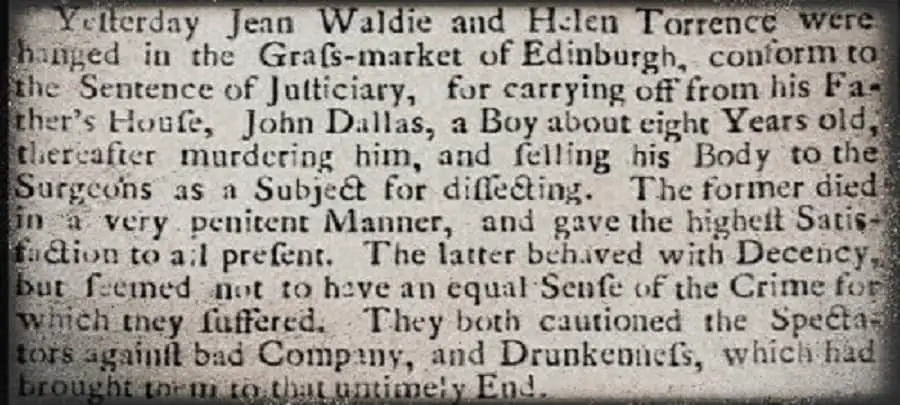
The Trial
On the day of the trial, details of John Dallas Jnr’s demise was given out fully in court.
Waldie had indeed enticed John away from the windowsill and
…took him in her arms and brought him directly to her house, and was immediately followed by the said Helen Torrence; that before she came in, she [Waldie] gave the child a drink of Ale, but that it would scarce go over, and that it died in about six minutes.
After only an hour’s deliberation by the jury, the trial adjourned for the evening so that the jury could contemplate their decision. By 1 pm the following day a decision had been reached by everyone involved.
Jean Waldie and Helen Torrence were both found guilty of
…stealing John Dallas a living child…and of carrying him to the House of Jean Waldie…and soon thereafter on the Evening of the Day libeled of selling and delivering his Body then dead to some Surgeons and Students of Physick.
Both women were sentenced to hang for their crimes.
On the scaffold, the women conducted themselves with decorum. Waldie openly admitted that the sentence she was about to receive was just and that little John Dallas had probably suffocated in the clothing as she was carrying him back to her lodgings.
Torrence, although behaving with ‘decency’, accounts say that she did not seem to have the same sense of understanding of the crimes that had been committed.
Despite Torrence having a failed attempt at ‘pleading her belly’ in the hope to delay her hanging, the pair were eventually executed in Edinburgh’s Grassmarket on 18 March 1752.
The same location that 77 years later murderer William Burke would be hanged for similar crimes.
Researching Waldie & Torrence
Maps
In trying to find the exact locations of the Closes’s that the three key figures lived in, I turned to the National Library of Scotland website, specifically their map section which you can find here.
After a little searching, I found that The plan of the City and Castle of Edinburgh by William Edgar Architect compiled in 1765, proved to be the most useful.
Plotted as Close’s No. 73 & 74 are of key interest here. No. 73 is New Assembly Close (formerly Fairlie’s Close) and No.74 is Stanelaw’s Close which, if you consider the phonetic spellings used during this period, I have taken to be the same as Stainielaw’s Close where John Dallas Jnr lived.
If you wish to view the map online for yourself, you can access a direct copy here
Newspapers
The Scots Magazine for 1752 reported on the case over a couple of pages in Trials For Murder & Riots etc. and you can read the accounts for yourself via the British Newspaper Archive
A simple search of Jean Waldie and Helen Torrence brings up over 1000 results of varying quality and length. You may wish to browse through these for your own interests.
Books
In many books relating to body snatching there can often be found some snippet or other relating to Waldie and Torrence. I find the most useful to be:
Fido. M. Bodysnatchers: A History of the Resurrectionists (1988)
Bailey. B. Burke and Hare The Year of the Ghouls (2002)
Adams. N. Scottish Bodysnatchers: True Accounts (2002)

